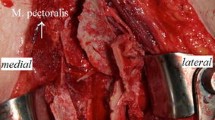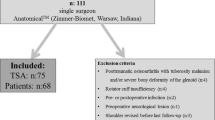Abstract
Background
Revision shoulder arthroplasty may involve the need to remove a well-fixed humeral stem. To avoid this, convertible platform systems have been introduced. The biomechanics of reverse total shoulder arthroplasty (rTSA) differs from anatomic shoulder arthroplasty (aTSA). The different humeral osteotomy and soft tissue tension may jeopardize the optimal results of the converted rTSA.
The aim was to evaluate the radiographic parameters of soft tissue distraction when converting an aTSA to rTSA in a platform system and assess the capability of conversion without “over-stuffing” the shoulder in the “best-case scenario”.
Methods
Radiographic analysis of soft tissue distraction parameters: difference in acromio-humeral distance, difference in lateral humeral offset and difference in latero-inferior displacement were evaluated in aTSA and in the converted rTSA in six different implants. Image analysing software was used on 10 non-deformed osteoarthritic shoulder X-rays to simulate conversion.
Results
The greatest increase in arm length was found for Tornier Ascend Flex (26.8 ± 3.6 mm) while the smallest increase was observed with Lima SMR (19.3 ± 4 mm).
The humerus remained most lateralized with the Zimmer Anatomical/Inverse ( − 1.4 ± 2.9 mm) while Lima SMR ( − 15.8 ± 2.7 mm) was more medialized. The greatest increase in latero-inferior distance was found in the onlay systems.
A group analysis of onlay rTSA showed an increase of 46% in arm length (p < 0.0001), 83% larger humeral offset (p < 0.0001) and 144% increase in latero-inferior distraction (p < 0.0001) when compared to inlay rTSA.
Conclusion
The conversion of aTSA to rTSA using a convertible platform system may lead to significant increase in radiographic parameters corresponding to soft tissue tension. This may alter the biomechanics, restrict the convertibility or jeopardize the optimal clinical outcome of rTSA even in the best-case scenario.





Similar content being viewed by others
References
Ackland DC, Pak P, Richardson M, Pandy MG (2008) Moment arms of the muscles crossing the anatomical shoulder. J Anat 213(4):383–390. https://doi.org/10.1111/j.1469-7580.2008.00965.x
Ackland DC, Pandy MG (2011) Moment arms of the shoulder muscles during axial rotation. J Orthop Res 29(5):658–667. https://doi.org/10.1002/jor.21269
Ackland DC, Roshan-Zamir S, Richardson M, Pandy MG (2010) Moment arms of the shoulder musculature after reverse total shoulder arthroplasty. J Bone Jt Surg Am 92(5):1221–1230. https://doi.org/10.2106/JBJS.I.00001
Boileau P (2016) Complications and revision of reverse total shoulder arthroplasty. Orthop Traumatol Surg Res 102(1):S33-43. https://doi.org/10.1016/j.otsr.2015.06.031
Boileau P, Watkinson DJ, Hatzidakis AM, Balg F (2005) Grammont reverse prosthesis: design, rationale, and biomechanics. J Shoulder Elbow Surg 14(1):147–161. https://doi.org/10.1016/j.jse.2004.10.006
Castagna A, Delcogliano M, de Caro F, Ziveri G, Borroni M, Gumina S et al (2013) Conversion of shoulder arthroplasty to reverse implants: clinical and radiological results using a modular system. Int Orthop 37(7):1297–1305. https://doi.org/10.1007/s00264-013-1907-4
Cisneros LGN, Atoun E, Abraham R, Tsvieli O, Bruguera J, Levy O (2016) Revision shoulder arthroplasty: does the stem really matter? J Shoulder Elbow Surg 25(5):747–755. https://doi.org/10.1016/j.jse.2015.10.007
Day JS, Lau E, Ong KL, Williams GR, Ramsey ML, Kurtz SM (2010) Prevalence and projections of total shoulder and elbow arthroplasty in the United States to 2015. J Shoulder Elbow Surg 19(8):1115–1120. https://doi.org/10.1016/j.jse.2010.02.009
Dilisio MF, Miller LR, Siegel EJ, Higgins LD (2015) Conversion to reverse shoulder arthroplasty: humeral stem retention versus revision. Orthopedics 38(9):773–779. https://doi.org/10.3928/01477447-20150902-54
Eichinger JK, Galvin JW (2015) Management of complications after total shoulder arthroplasty. Curr Rev Musculoskelet Med 8(1):83–91. https://doi.org/10.1007/s12178-014-9251-x
Favard L (2013) Revision of total shoulder arthroplasty. Orthop Traumatol Surg Res 99(1):12–21. https://doi.org/10.1016/j.otsr.2012.11.010
Habermeyer P, Lichtenberg S, Tauber M, Magosch P (2015) Midterm results of stemless shoulder arthroplasty: a prospective study. J Shoulder Elbow Surg 24(9):1463–1472. https://doi.org/10.1016/j.jse.2015.02.023
Hasan SS, Leith JM, Campbell B, Kapil R, Smith KL, Matsen FA (2002) Characteristics of unsatisfactory shoulder arthroplasties. J Shoulder Elbow Surg 11(5):431–441
Hoenecke HRJ, Flores-Hernandez C, D’Lima DD (2014) Reverse total shoulder arthroplasty component center of rotation affects muscle function. J Shoulder Elbow Surg 23(8):1128–1135. https://doi.org/10.1016/j.jse.2013.11.025
Hollatz MF, Stang A (2014) Nationwide shoulder arthroplasty rates and revision burden in Germany: analysis of the national hospitalization data 2005 to 2006. J Shoulder Elbow Surg 23(11):267–274. https://doi.org/10.1016/j.jse.2013.12.008
Iannotti JP, Gabriel JP, Schneck SL, Evans BG, Misra S (1992) The normal glenohumeral relationships. An anatomical study of one hundred and forty shoulders. J Bone Jt Surg Am 74(4):491–500
Jouve F, Walch G. Révisions humérales (2008) options thérapeutiques Humeral stem removal: surgical technique BT-Prothèses d’épaule État actuel. Elsevier Masson, Paris, p 415–421
Kany J, Amouyel T, Flamand O, Katz D, Valenti P (2014) A convertible shoulder system: is it useful in total shoulder arthroplasty revisions? Int Orthop 39(2):299–304. https://doi.org/10.1007/s00264-014-2563-z
Levy O, Copeland SA (2001) Cementless surface replacement arthroplasty of the shoulder. 5- to 10-year results with the Copeland mark-2 prosthesis. J Bone Jt Surg Br 83(2):213–221
Levy O, Tsvieli O, Merchant J, Young L, Trimarchi A, Dattani R et al (2015) Surface replacement arthroplasty for glenohumeral arthropathy in patients aged younger than fifty years: results after a minimum ten-year follow-up. J Shoulder Elbow Surg 24(7):1049–1060. https://doi.org/10.1016/j.jse.2014.11.035
Matsen FA 3rd, Li N, Gao H, Yuan S, Russ SM, Sampson PD (2015) Factors affecting length of stay, readmission, and revision after shoulder arthroplasty: a population-based study. J Bone Jt Surg Am 97(15):1255–1263. https://doi.org/10.2106/JBJS.N.01107
Roche C, Flurin P-H, Wright T, Crosby LA, Mauldin M, Zuckerman JD (2009) An evaluation of the relationships between reverse shoulder design parameters and range of motion, impingement, and stability. J Shoulder Elbow Surg 18(5):734–741. https://doi.org/10.1016/j.jse.2008.12.008
Streit JJ, Shishani Y, Gobezie R (2015) Medialized versus lateralized center of rotation in reverse shoulder arthroplasty. Orthopedics 38(12):1098–1103. https://doi.org/10.3928/01477447-20151120-06
Teschner H, Vaske B, Albrecht UV, Meller R, Liodakis E, Wiebking U et al (2014) Conversion of hemi into reverse shoulder arthroplasty: implant design limitations. Arch Orthop Trauma Surg 134(12):1683–1689. https://doi.org/10.1007/s00402-014-2098-1
Walker DR, Kinney AL, Wright TW, Banks SA (2016) How sensitive is the deltoid moment arm to humeral offset changes with reverse total shoulder arthroplasty? J Shoulder Elbow Surg 25(6):998–1004. https://doi.org/10.1016/j.jse.2015.10.028
Werner BC, Dines JS, Dines DM (2016) Platform systems in shoulder arthroplasty. Curr Rev Musculoskelet Med 9(1):49–53. https://doi.org/10.1007/s12178-016-9317-z
Wieser K, Borbas P, Ek ET, Meyer DC, Gerber C (2014) Conversion of stemmed hemi- or total to reverse total shoulder arthroplasty: advantages of a modular stem design. Clin Orthop Relat Res 473(2):651–660. https://doi.org/10.1007/s11999-014-3985-z
Funding
Albert Ferrando did not receive any financial payments or other benefits from any commercial entity related to the subject of this article. Luis Natera did not receive any financial payments or other benefits from any commercial entity related to the subject of this article. Berta Buch did not receive any financial payments or other benefits from any commercial entity related to the subject of this article. Paolo Consigliere reports grants from Arthrex, outside the submitted work. Mr. G. Sforza reports other from IDO Innovative Design Orthopaedics, during the conduct of the study; non-financial support from Arthrex, outside the submitted work; Dr. Atoun reports personal fees from Minivasive, outside the submitted work. Prof. Levy reports other from Innovative design orthopaedics (IDO), during the conduct of the study; personal fees from Collplant, personal fees from Estar-Medical, personal fees from Minivasive, outside the submitted work.
Author information
Authors and Affiliations
Corresponding author
Ethics declarations
Conflicts of interest
The author(s) declare that they have no conflicts of interest.
Additional information
Publisher's Note
Springer Nature remains neutral with regard to jurisdictional claims in published maps and institutional affiliations.
Rights and permissions
About this article
Cite this article
Ferrando, A., Natera, L., Buch, B. et al. Software simulations of changing offsets and thus soft tissue tension when revising anatomic to reverse total shoulder arthroplasty in convertible platform systems. Eur J Orthop Surg Traumatol 31, 611–619 (2021). https://doi.org/10.1007/s00590-020-02812-1
Received:
Accepted:
Published:
Issue Date:
DOI: https://doi.org/10.1007/s00590-020-02812-1




